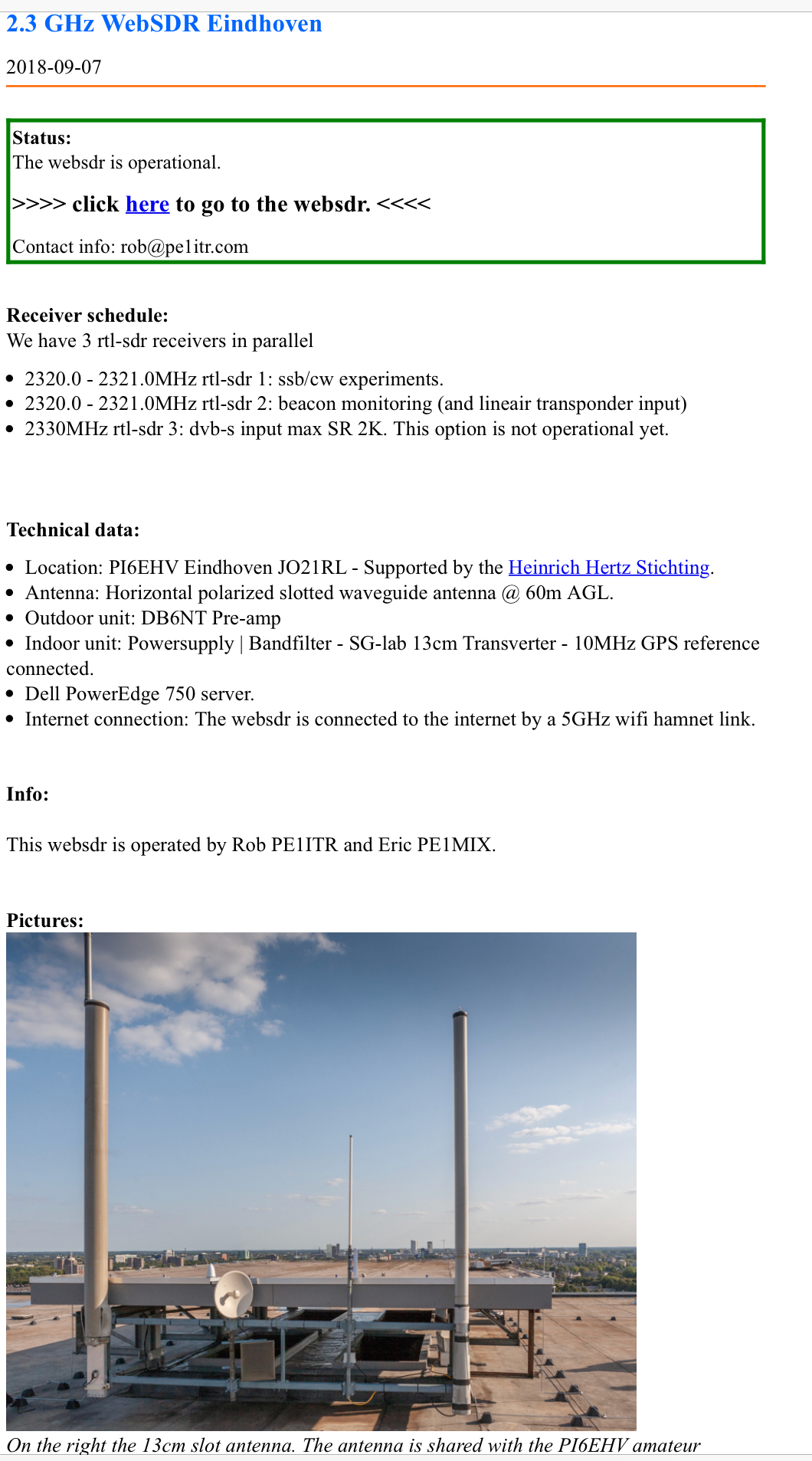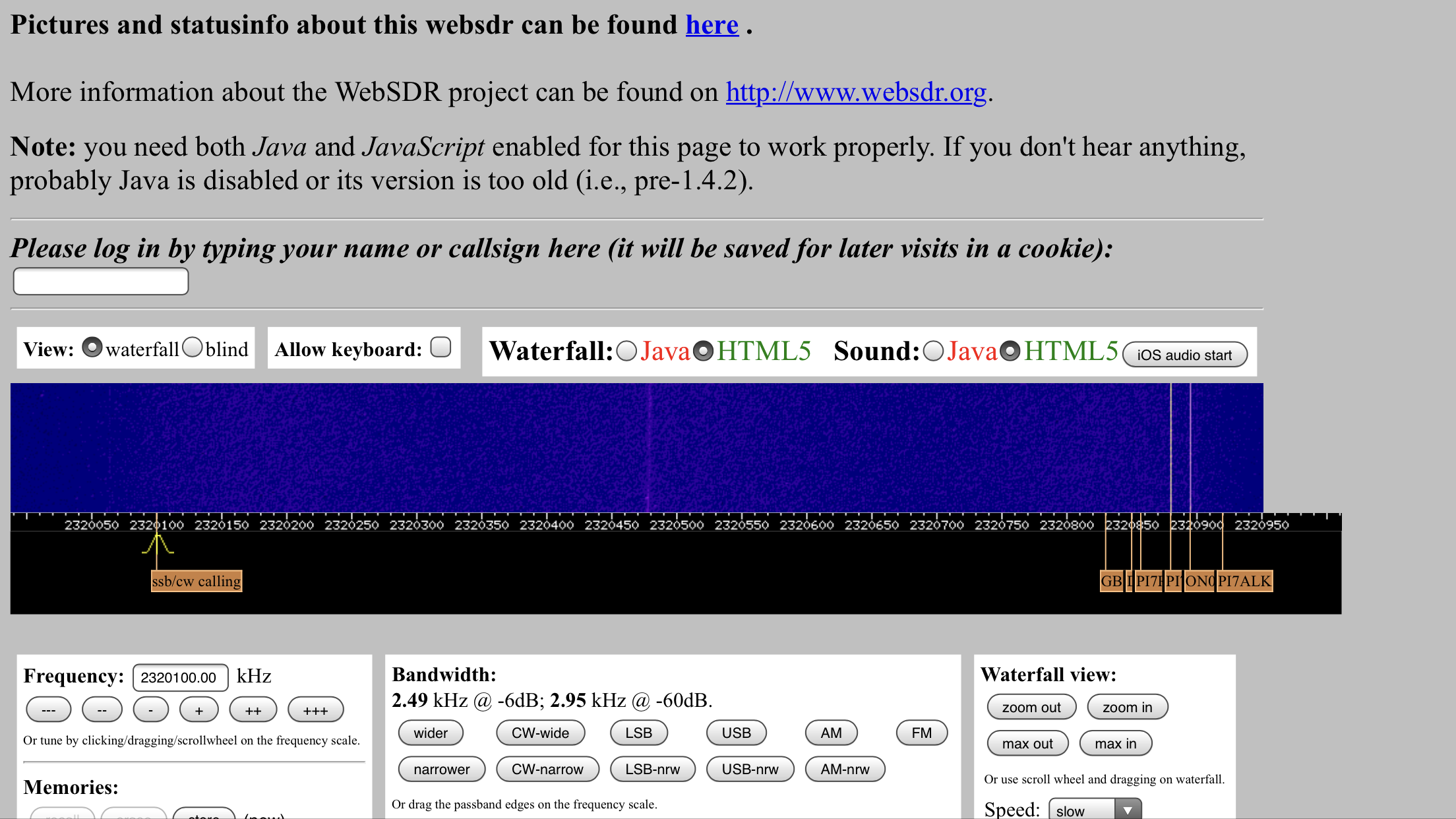WebSDR op 2.3GHz actief in Eindhoven
Meer informatie vind het hier!
ADALM-PLUTO (“PLUTO SDR”): Eerste indruk!
Bron: vma-satellite.blogspot.com
Hello,
Here is my first experience with the ADALM-PLUTO:
- Ordered in October 2017 at Mouser.
- Received the item February, 28th 2018 – almost 5 months later… Patience is a virtue.
- I paid a total cost of 90 Euro with shipping included and no customs issue.
- Once the product was in stock at Mouser, shipping took 2-3 days.
What is in the box?
- 1x ADALM-PLUTO
- 2x Small SMA antennas
- 1x SMA cable (female to female)
- 1x USB Micro cable (like the ones used for modern smartphones)
Note: You need a USB charger to power the ADALM-PLUTO. It has two Micro-USB connectors, one is for connection to the PC, the other is for the power supply!
First steps (I only used Windows 10 @ 64bits so far):
- Downloaded and installed the drivers -> no issues
- After reboot, I opened the browser with 192.168.2.1 and got the ADALM-PLUTO welcome screen. Note that it does not matter that your PC is on a different subnet! This got me slightly confused in the beginning. Just type this address and off you go.
- Did a putty connection over COM port at 9600 baud. Did the “hack” with no issues. This will increase the bandwidth from 70MHz up to 6GHz.
You just need to type these two commands on the PUTTY remote connection (note that on the telnet screen, the user is “root” and the password “analog”:
# fw_setenv attr_name compatible # fw_setenv attr_val ad9364 # reboot
- Tried SDRsharp with the plugin -> no issues, but performance is much worse than with HackRF One (max. bandwidth is 5MHz, while HackRF One manages 10MHz without any problem – no sound clicking or other issues).
- Tried sdrangel -> works great (albeit with smaller bandwidth than the HackRF One). Had issues with the TX plugin, turned out that Windows Protection thinks that one of the output sinks is a malware and deletes it. Made a rule to not scan sdrangel folder and now it works fine.
- Tried Matlab -> works fine, but costs money (I have access to Uni license) and seems very similar to GNU Radio. Not sure what the benefit of having Matlab is, as I am not literate in Matlab.
- Tried GNU Radio -> No sink to support Pluto SDR under Windows available: bummer (dat is nu wel het geval noot redactie).
So far I was not too impressed by the ADALM-PLUTO, compared with the HackRF One. The “hackrf tools” included for the HackRF One, that allow to record and replay frequency ranges are pretty awesome (using hackrf_transfer). Also, there is more software available for the HackRF One, with much better support for Windows. Finally, you get a bigger effective bandwidth with the HackRF One.
Tried DATV-Express: AWESOME!!! This tool alone makes the purchase worth it. Being able to generate a DVB-S/DVB-S2 transponder that you can use to test SAT-Receivers without having access to a dish is amazing, especially considering that the hardware costs just 90 Euro! I have several Dektec Modulators, which cost a few thousand Euro (well, they support much higher bandwidth and functionality, but that is not the point).
I did have some issues with DVB-T, as the two field meter I tried only support 6, 7 or 8 MHz bandwidth. The ADALM-PLUTO does not support a continuous stream at this rate, so I couldn’t test it further.
But DVB-S/S2 is great!
Conclusion:
Much potential for the ADALM-PLUTO (“Pluto SDR”), at a great price but with an unacceptably high waiting time. This seems understandable, because the demand must be overwhealming. I cannot imagine this tool being actually used at schools, as you simply cannot get hold of it.
But I predict that many cool software applications will emerge for this product, once it is more easily obtainable.
Regards,
Vitor

